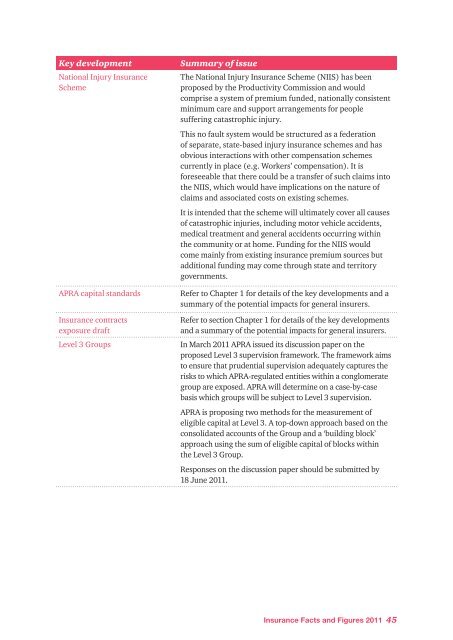PwC Insurance Facts and Figures 2011 - PricewaterhouseCoopers
PwC Insurance Facts and Figures 2011 - PricewaterhouseCoopers
PwC Insurance Facts and Figures 2011 - PricewaterhouseCoopers
Create successful ePaper yourself
Turn your PDF publications into a flip-book with our unique Google optimized e-Paper software.
Key development<br />
National Injury <strong>Insurance</strong><br />
Scheme<br />
APRA capital st<strong>and</strong>ards<br />
<strong>Insurance</strong> contracts<br />
exposure draft<br />
Level 3 Groups<br />
Summary of issue<br />
The National Injury <strong>Insurance</strong> Scheme (NIIS) has been<br />
proposed by the Productivity Commission <strong>and</strong> would<br />
comprise a system of premium funded, nationally consistent<br />
minimum care <strong>and</strong> support arrangements for people<br />
suffering catastrophic injury.<br />
This no fault system would be structured as a federation<br />
of separate, state-based injury insurance schemes <strong>and</strong> has<br />
obvious interactions with other compensation schemes<br />
currently in place (e.g. Workers’ compensation). It is<br />
foreseeable that there could be a transfer of such claims into<br />
the NIIS, which would have implications on the nature of<br />
claims <strong>and</strong> associated costs on existing schemes.<br />
It is intended that the scheme will ultimately cover all causes<br />
of catastrophic injuries, including motor vehicle accidents,<br />
medical treatment <strong>and</strong> general accidents occurring within<br />
the community or at home. Funding for the NIIS would<br />
come mainly from existing insurance premium sources but<br />
additional funding may come through state <strong>and</strong> territory<br />
governments.<br />
Refer to Chapter 1 for details of the key developments <strong>and</strong> a<br />
summary of the potential impacts for general insurers.<br />
Refer to section Chapter 1 for details of the key developments<br />
<strong>and</strong> a summary of the potential impacts for general insurers.<br />
In March <strong>2011</strong> APRA issued its discussion paper on the<br />
proposed Level 3 supervision framework. The framework aims<br />
to ensure that prudential supervision adequately captures the<br />
risks to which APRA-regulated entities within a conglomerate<br />
group are exposed. APRA will determine on a case-by-case<br />
basis which groups will be subject to Level 3 supervision.<br />
APRA is proposing two methods for the measurement of<br />
eligible capital at Level 3. A top-down approach based on the<br />
consolidated accounts of the Group <strong>and</strong> a ‘building block’<br />
approach using the sum of eligible capital of blocks within<br />
the Level 3 Group.<br />
Responses on the discussion paper should be submitted by<br />
18 June <strong>2011</strong>.<br />
<strong>Insurance</strong> <strong>Facts</strong> <strong>and</strong> <strong>Figures</strong> <strong>2011</strong> 45
















